Canada’s Warming Arctic – Gepolitical Implications
Politics / Climate Change Nov 09, 2020 - 12:58 PM GMTBy: Richard_Mills
Canada’s identity is inextricably tied to the United States, and Canadians share much with their American neighbors, including popular culture, tourism, and the world’s longest undefended border. The amount of trade between the United States and Canada, an estimated $718.4 billion in 2019, is bested only by the sum total of goods and services exchanged between the US and China. Hundreds of Canadian businesses rely on goods and services produced state-side, and vice versa, making the supply chains between the two countries inextricable.
American news and politics is widely covered by Canadian media, not only for its public interest but because the influence of our southern neighbor is so pervasive, in political and economic life. As a former prime minister put it, “Living next to the US is like sleeping next to an elephant.”
Yet Canada has another identity, or rather, a different aspect of the same personality – one that is decidedly northern in geography and character. Above all, pun intended, Canada is an Arctic nation.
What defines the Canadian Arctic? The question appears easy at first blush. Tapping our collective imagination, which is all we have as most have never been there, most Canadians would answer, “everything north of the tree line” or more astutely, “territory that lies within the Arctic Circle.” Both are correct, yet vague.
Maps published by the Canadian government show a boundary that follows the 60th parallel north, dives abruptly south along Hudson Bay, then cuts back onto land as it crosses northern Quebec and Labrador.
North of the mainland is a maze of islands separated by convoluted straits and sounds, the most famous being the fabled Northwest Passage, thought by early explorers to be the northern route to the Orient. The Canadian Arctic Archipelago comprises an astonishing 36,563 islands, 94 of which are classified as major islands, and 1.424 million square kilometers. It extends 1,900 km from the mainland to Cape Columbia, the northern-most point on Ellesmere Island, and is bounded on the west by the Beaufort Sea, by the Arctic Ocean on the northwest, and on the east by Greenland, Baffin Bay and Davis Strait.
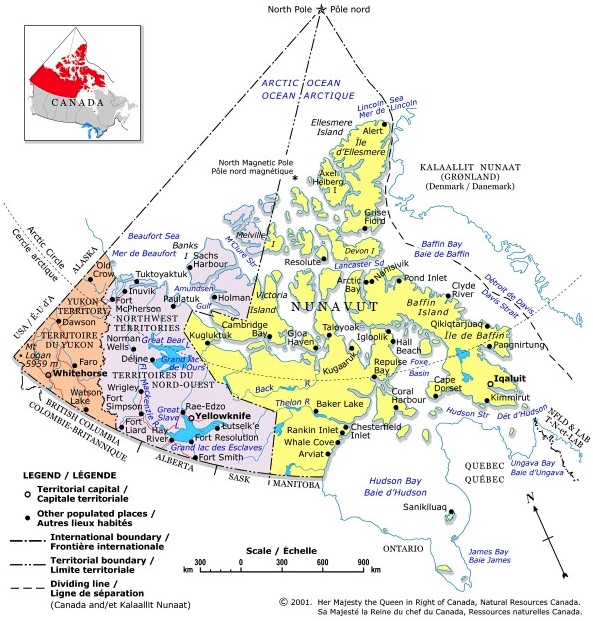
After Greenland, the archipelago is the world’s largest high-Arctic land area. Most of the islands are uninhabited, with human settlement thin and scattered. Although the Arctic makes up 40% of Canada’s land mass, only about 150,000 people – less than 1% of the population, live there. Over half of its residents are Aboriginal, comprised of First Nation, Inuit and Metis peoples; a significant proportion of the Aboriginal people live in small, isolated communities.
But what it lacks in people, the Canadian Arctic makes up for in resources. The sprawling region contains about 10% of the world’s fresh water and has world-class oil, gas and mineral deposits, including iron ore, copper, nickel and diamonds – hidden beneath frozen oceans and meters-thick glaciers that are thawing rapidly.
As global warming melts the sea ice, shipping lanes once too icy to navigate are opening up to global trade. According to NASA, the Arctic Ocean is expected to become ice free in summer before mid-century.
This has triggered a fierce debate over sovereignty, and a land grab for resources, particularly oil and gas. Although Canada claims the Northwest Passage as its own, the US and other maritime countries view it as international waters.
Other contested areas include a long-standing border dispute between Canada and the US over a large part of the Beaufort Sea, and a disagreement over who owns tiny Hans Island, Canada or Denmark? Every Arctic nation has competing territorial claims with Russia.
Under the United Nations Convention on the Law of the Sea (UNCLOS), each Arctic country has exclusive economic rights including the right to drill for oil and gas, in waters up to 200 nautical miles – known as the 200-mile limit. Beyond that, a country can extend its territorial claims to 350 miles, if it can show its continental shelf goes that far out.
To help find common ground, the Arctic Council was formed in 1996 to promote cooperation among the Arctic states. The organization has become an increasingly robust international bureaucracy, that develops joint initiatives on a range of Arctic issues, from protecting indigenous communities to oil-spill response.
The Arctic Council is comprised of eight member states who implement regional policy: Canada, Denmark (through Greenland/ the Faroe Islands), Finland, Iceland, Norway, Russia, Sweden and the United States. Canada held the first Chair of the Arctic Council from 1996 to 1998, and again from 2013-2015.
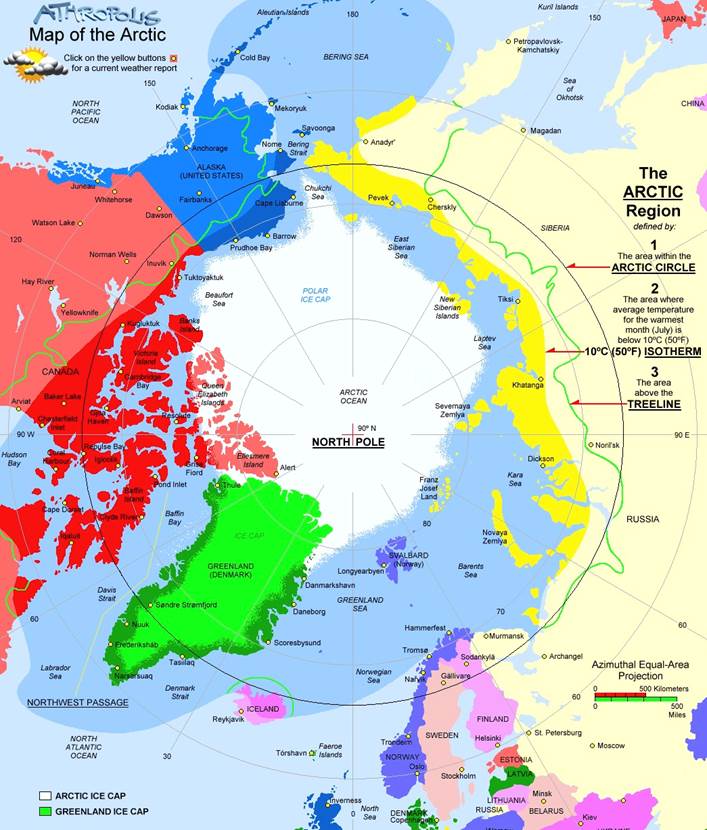
Arctic warming
Climate is among a half-dozen target issues displayed prominently on the Arctic Council’s website. It states,
The temperatures in the Arctic continue to rise at more than twice the global annual average, driving many of the changes underway in the Arctic. Most prominently, snow and ice are melting at an increasing rate. This impacts both local ecosystems and the global climate system. It contributes to rising sea levels, and is likely to provoke extreme temperature events beyond the Arctic. The effects of a shifting Arctic climate are felt across the high latitudes and beyond – with global environmental, economic, and social implications.
It’s no secret that the Canadian Arctic, and its polar neighbors touching the Arctic Circle, have a serious problem with global warming. Last year the federal government released a scientific report claiming that Canada is warming at a rate twice as fast as the rest of the world – and will continue to warm at more than double the global rate.
On average, Canada’s annual average temperature has warmed an estimated 1.7 degrees C (3F) since 1948; in northern Canada, the temperature increase was approximately +2.3C.

According to the report, rapid warming is due to a number of factors, including loss of glaciers, snow and sea ice, thereby increasing absorption of solar radiation and causing larger surface warming than in other regions.
When sea ice is lost, the sunlight is no longer reflected back to the atmosphere, but rather gets absorbed into the open ocean. This exacerbates ocean warming, and forms a warming cycle, or “feedback loop”. Warmer water temperatures delay the growth of ice in fall and winter, and the ice melts faster in the spring, exposing patches of open ocean for longer periods during summer, and further warming the ocean.
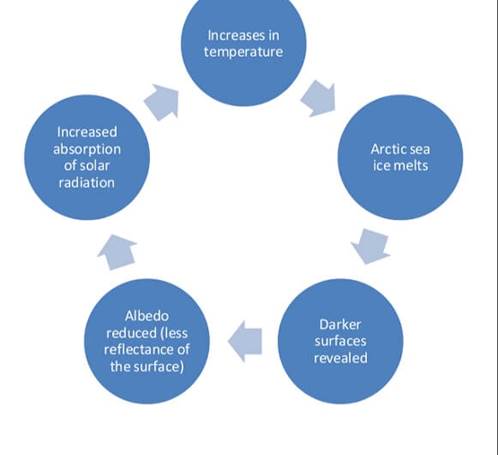
A presentation by Leslie Whitby, of Indian and Northern Affairs Canada, states that in the 1990’s, emerging evidence suggested that the Arctic climate was changing. Examples included large reductions in sea ice and glacier volume; increases in river runoff and sea level; rises in surface and ocean temperature; increases in precipitation; thawing of permafrost; shifts in the ranges of plant and animal species; and impacts on residents of the circumpolar Arctic region.
2019 was one of the Arctic hottest summers ever recorded. The average annual land surface air temperature north of 60 degrees between October 2018 and August 2019 was the second warmest since 1900. As National Geographic reported, Summer sea ice [last] year shrank to its second lowest extent since satellite measurements began in 1979, while record July heat melted billions of tons of ice off the Greenland ice sheet. Wildfires blazed across millions of acres from Alaska to Siberia.
For the first six months of 2020, Siberia experienced abnormally high temperatures, including a record-breaking 38 degrees in the town of Verkhoyansk on June 20. Riding on the heatwave’s coat-tails was another round of wildfires, loss of permafrost and an invasion of pests.
Northern waters have also warmed considerably. August mean sea surface temperatures in 2019 were 1 to 7°C warmer than the 1982-2010 August mean in the Beaufort and Chukchi seas, the Laptev Sea and Baffin Bay.
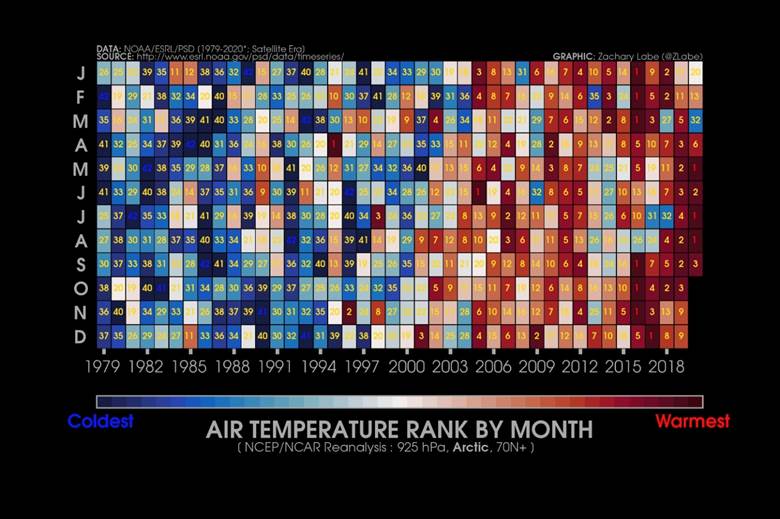
Melting ice, rising seas
The warming of the Earth’s surface has caused a widespread retreat of the glaciers at both poles.
According to the 2019 Arctic Report Card, the Greenland ice sheet is losing nearly 267 billion metric tons of ice per year. Melting of the continent-sized island started early in 2019 and and reportedly reached historically high levels when warm air from Europe’s heat wave turned ice to water over more than 90% of its surface.
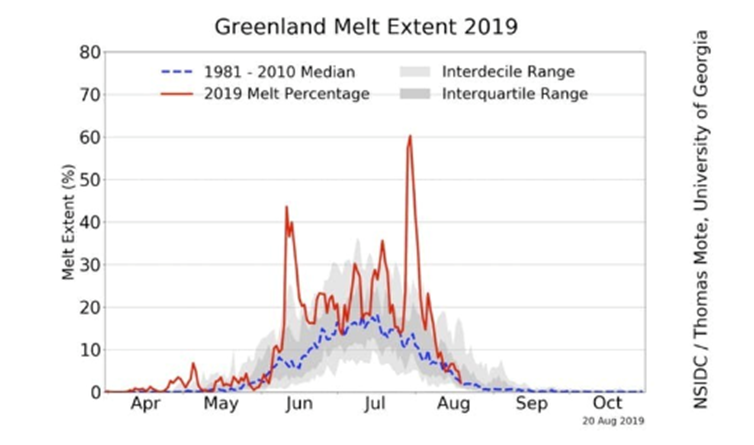
Meanwhile Arctic sea ice measured in September - when it is thinnest - is now declining at a rate of 13.2% per decade. In fact, there is evidence to indicate that sea ice extent has not been this low for at least the last 1,500 years, The Conversation reports. Extreme melt events over the Greenland Ice Sheet, that used to occur once in every 150 years, have been seen in 2012 and now 2019. Ice core data shows that the enhanced surface melting on the ice sheet over the past decade is unprecedented over the past three and a half centuries and potentially over the past 7,000 years.
In September 2020 Arctic sea ice averaged 3.92 million square kilometers, the second lowest in a 42-year satellite record, behind only September 2012. The ice cover is also thinner, making it more vulnerable to warming air and oceans.
Climate scientists predict if emissions levels continue, summer sea ice will disappear within the next 20 to 25 years. The maps below show the loss of north polar sea ice in October, 1985 versus October 2015.
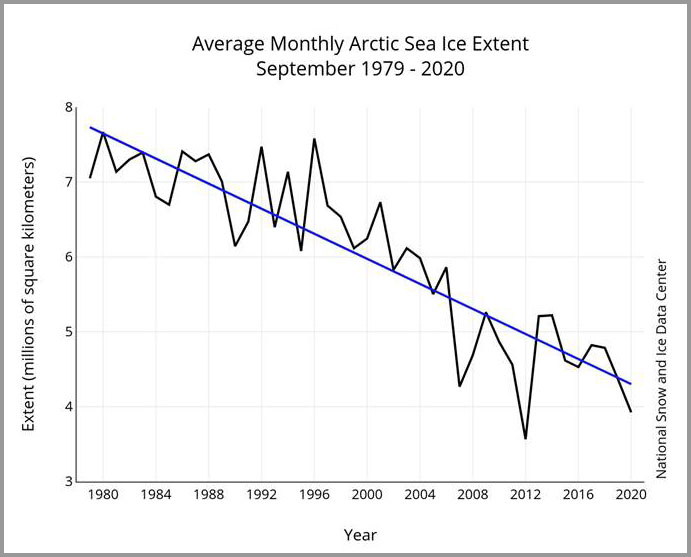
All of this melting ice has caused sea levels to rise, from between seven and eight inches over the last 117 years, NASA states, with the most rise occurring since 1993. Higher sea levels are also caused by the expansion of ocean water as it warms. The latest International Panel on Climate Change report predicts sea levels rising between 20 and 38 inches by 2100 if rising temperatures do not stop. An increase of 65 centimeters, or roughly two feet, is expected to cause significant flooding in coastal cities.
What would happen if the Earth warmed by 3 degrees, just one more degree than currently? According to scientists the effects would be calamitous. With eight out of the 10 largest cities near a coast, several millions would be at risk of flooding, shoreline erosion and storm surges. The worst-hit cities would be in Asia, including Shanghai, Hong Kong and Osaka. Rio de Janeiro, Miami, The Hague, and Alexandria are also included among the most populated, at-risk cities. Climate Central ranked the 25 US cities most at risk of coastal flooding and sea level rise. It found that New York is most likely to have problems, with Miami second. Twenty-two of the 25 cities are in Florida.
Thawing permafrost
Along with calving glaciers, shrinking ice caps and disappearing sea ice, evidence of Arctic warming can also be seen in the thawing of permafrost. Permafrost is land that is permanently frozen except for the top layer, which freezes in the winter and thaws in the summer; 70% of Russia sits on permafrost, which in some areas is over a kilometer deep. When it melts, permafrost exposes carbon dioxide and methane, a greenhouse gas that is about 30 times more powerful than CO2, in terms of its ability to trap heat.
Arctic permafrost in 2017 reached record warm temperatures. It’s estimated that this phenomenon could release between 300 million and 600 million tons of net carbon per year into the atmosphere.
Another negative impact of melting permafrost, is subsidence. This is what happens when the surface layer gets deeper and the structures (like houses and industrial buildings) embedded in it start to fail as the ground beneath them expands and contracts.
Climatologist predict that an estimated 2.5 million square miles of permafrost, or 40% of the world’s total, could disappear by the end of this century, significantly accelerating global temperature rise.
Weakening polar vortex
The effects of climate change on the Arctic are bad enough if confined to the Arctic Circle. However, there is growing evidence that what is happening there is the canary in the coal mine of a larger global problem, with far-reaching consequences that will be seen and felt in more populated southern regions.
The polar vortex is a seasonal atmospheric phenomenon whereby high winds swirl around an extremely cold pocket of Arctic or Antarctic air. The winds are like a barrier that contains cold air, but when the vortex weakens, the frigid air “escapes” from the vortex and travels south, bringing with it a freezing cold blast of Arctic weather. In 1985, the northern polar vortex became so distorted that cold air pushed down as far as Florida, destroying the normally balmy state’s orange crop.
How does climate change affect the polar vortices? The answer is warming oceans. As more ice melts during the summer, the Arctic Ocean heats up. The effect is less pronounced in Antarctica because it’s a land form, not a polar ice cap. That heat gets radiated back to the atmosphere in winter, which reduces the intensity of the northern polar vortex winds. The polar vortex gets disrupted, allowing cold air in the center of the swirling cyclone above the pole to migrate south. According to Scientific American, in years when a lot of Arctic sea ice disappeared, the vortex was more likely to weaken.
Along with escaping cold Arctic air that flows into parts of the Northern Hemisphere, a distorted polar vortex also warms polar regions. This is the phenomenon of the “wavering jet stream”. The polar-front jet stream crosses the North Atlantic from west to east and determines the paths of weather systems. As the Arctic warms, this theory suggests, it causes the jet stream to become weaker and wavier, allowing cold polar air to reach further south and warm air to stretch north. This makes weather systems linger in the same locations for longer, such as the 2019 summer hot spell that baked Europe, and the cold snap that froze the eastern and midwestern United States the same year.
The breakdown of the polar vortex and wavering jet stream theory are a good defense of global warming against critics who claim that exceedingly cold winters in certain cities are proof that climate change isn’t real; in fact these events are just another manifestation of our changing climate.
A study in the Bulletin of the American Meteorological Society found that a weakening polar vortex has become more common during the past four decades, and that a weaker polar vortex, brought on by a melting Arctic, explained 60% of the cooling in Eurasia since 1990. The scary part of all this is the specter of the polar vortex collapsing. This would mean a total disruption of normal atmospheric warming and cooling. Without halos of swirling Arctic and Antarctic winds serving to cool the poles, they would be left to heat up, accelerating global warming.
Forbes writes: What's concerning is the frequency and duration of breakdowns in the polar vortex, indicating its potential collapse. While the strength of the polar vortex relies on the temperature difference between the mid-latitudes and the Arctic we concurrently see increasing average temperatures in the pole. In addition, NASA puts the rate of declining Arctic sea ice at 13.2% per decade. These signs point to a continued weakening of the polar vortex and a potential collapse.
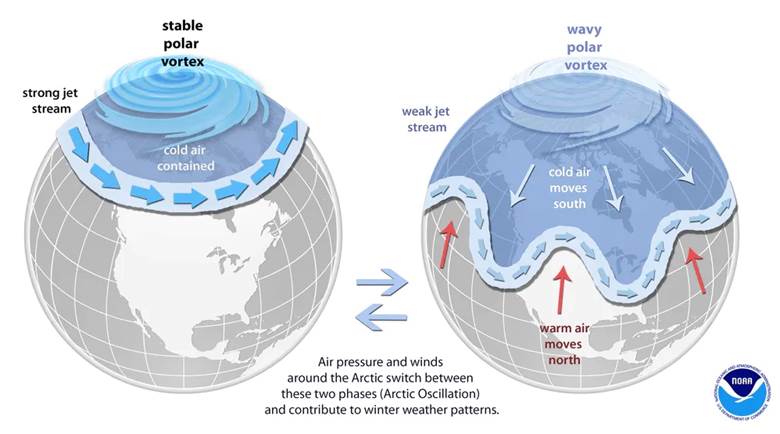
Animal life
There are many environmental effects of Arctic climate change, but as important are the consequences of changing conditions for animal species and the Arctic’s human inhabitants, most of whom define themselves as Aboriginal.
Many Arctic animals are uniquely adapted to life above the tree line, and rely on the seasonal presence of sea ice, whose loss is causing concern that ice-dependent species will decline, or be forced to adapt as coastal habitats disappear.
Less and thinner ice is also creating more opportunities for human activity in the Arctic, such as increased oil and gas tankers which bother whales and other marine mammals. A longer window of open water allows for more oil and gas exploration, tourism, commercial fishing and military operations, all of which put land and sea animals into potential conflict with people.
Wildlife populations are already showing signs of stress. For example the breeding population of the ivory gull in the Canadian Arctic has declined by 70% since the 1980s.
A story last year in Wired gives a good overview of the problem these animals are facing. It quotes Kristin Laidre, an animal ecologist at the University of Washington, who says the melting summer sea ice is causing trouble for big mammals: polar bears, walruses, and seals. She says they are struggling to survive because they can’t hunt, rest, or give birth on floating sea ice.
“They all rely heavily on the sea ice platform for all aspects of their life,” Laidre says. “As we continue to lose ice and see the changes in the ecosystem, we are already seeing big changes and we expect it to continue. There’s no way around that.”
With less sea ice to haul out on, seals and walruses are crowding onto beaches, leading to more trampling deaths of younger animals. Polar bears are swimming longer distances from land to the ice floes where they hunt seals. As the rest of the world’s oceans warm as well, coldwater fish, crustaceans, and plankton are moving north to the Arctic. That brings new diseases, parasites, and other threats to the marine life that already lives there, she says.
Climate change is also affecting land mammals like reindeer and caribou that are the main source of food for indigenous peoples of Canada, Siberia, and other Arctic nations. Reindeer are being decimated by rainfall over ice, which killed tens of thousands of animals in the past decade. In Greenland, botanists are discovering some flowering plants are emerging earlier each year, but not the pollinating insects they rely on.
Digging a little deeper, we find that Bering and Barents Seas fisheries have experienced a northerly shift in the distribution of subarctic and Arctic fish species, linked to the loss of sea ice and changes in bottom water temperature.
Spring plant growth is coming earlier, which means that tundra-feeding animals like caribou arrive at their annual birthing grounds after the plants they eat have passed their nutritional peak.
Ever wondered why shrinking sea ice is so devastating to polar bears? The reason has to do with the king predator’s primary diet of seals. Despite sitting around most of the time, polar bears burn through over 12,000 calories a day. To save energy while they are hunting, polar bears wait beside the seals’ breathing holes in the ice. When one emerges, the bear stands on its hind legs and bashes it on the head with both front paws to stun it, before biting it on the neck and dragging it onto the ice.
Because the ice is breaking up sooner and forming later in the fall, the bears are forced to burn huge amounts of energy walking or swimming, to get to any remaining ice, for hunting seals.
The problem is especially acute for pregnant females, who need to get fat from seals before they hibernate, and will rely on their extra padding for the energy they need to give birth to and nurse cubs the following spring.
The decline of polar ice hunting grounds is already having an effect on polar bear populations. According to the World Wildlife Federation (WWF),The abundance of Western Hudson Bay polar bears has declined by 30 per cent—from an estimated 1,200 animals in 1987 to just 842 in 2016. The production of litters declined by 39.7 per cent from 2001 to 2004 and from 2017 to 2019. The persistence of polar bears as a species depends on their ability to reproduce. Continued reductions are likely to lead to further declines in the abundance of the Western Hudson Bay subpopulation.
In the Beaufort Sea region, the well-studied population of polar bears has fallen 40% in the last 10 years. Polar bears are an endangered species in the US and are listed as vulnerable by the International Union for Conservation of Nature (IUCN).
Walruses are another Arctic animal being negatively impacted by disappearing sea ice. The lumbering beasts use the ice as a platform for resting and where mothers can leave their young calves between dives. Over the past decade, the ice has receded hundreds of kilometers north of the shallow continental shelf, forcing tens of thousands of Pacific walruses ashore. As WWF describes it,
These mass gatherings are deadly. Stampedes occur as easily spooked walruses trample one another in their attempt to reach the water. Many walruses, particularly young calves, die. Those that do survive must travel exhausting distances to find food, as nearby sources are quickly depleted.
It is especially saddening to watch what is happening to Arctic reindeer, a species so evocative of the Christmas season for Northern Hemisphere populations. For reindeer herders in Siberia, melting permafrost has turned the surface layer into water, eliminating the frozen tundra that reindeer normally scrape away with their hooves to feed on fungi and lichen.
Climate change is also messing up the timing of their migration. This past August in the village of Katanga, Russia, locals observed a herd of Taimyr reindeer migrating through their village weeks earlier than usual. Up to 200 calves, not strong enough to cross the kilometer-wide Khatanga River, perished or were abandoned by the herd. WWF reports that another type of reindeer in the Taimyr Peninsula, the Yenisei, has completely disappeared, while a herd known as the Tarey group, which numbered 44,000 in 2017, is down to a few thousand.
Way of life under threat
In the above-cited Arctic Report Card, indigenous elders from Bering Sea communities noted that, “[i]n a warming Arctic, access to our subsistence foods is shrinking and becoming more hazardous to hunt and fish. At the same time, thawing permafrost and more frequent and higher storm surges increasingly threaten our homes, schools, airports, and utilities.”
Among the issues the indigenous authors highlighted in the report card, were the detrimental impacts of declining sea ice on marine mammals, seabirds and communities. For example a slower fall freeze-up leaves communities stranded for longer periods of the year -- unable to travel to nearby villages or health care. Many residents go by snowmobile over sea ice to reach traditional hunting and fishing grounds, but the ice is becoming too thin to support the weight. Thinning ice is also complicating air and helicopter access to some communities.
Many Arctic inhabitants worry that their way of life is disappearing with the ice. A 2018 article about the Canadian Inuit, living in Labrador, describes how skills learned from older generations, like hunting, may soon become irrelevant, with more and more Inuit relying on store-bought food because it’s safer and easier than catching or shooting supper.
“I’m seeing changes that impact the way that we live,” The Guardian quotes hunter and trapper Derrick Pottle. “The sea, the ice, the snow, it’s all changing. You can’t travel safely anymore. Up and down the coast, it’s the same thing. And it’s changing right before our eyes.”
There is also the problem of coastal erosion and thawing permafrost. Rising sea levels and a reduction in sea ice allow higher waves and storm surges to reach shore. Thawing permafrost weakens coastal lands, adding to their vulnerability. The risk of flooding in coastal wetlands is projected to increase, with impacts on society and natural ecosystems. In some cases, communities and industrial facilities in coastal zones are already threatened or being forced to relocate, while others face increasing risks and costs.
As frozen ground thaws, Arctic industrial activities, including oil and gas extraction and forestry, are also under threat. Many existing buildings, roads, pipelines, airports and industrial facilities are likely to be destabilized, and will have to be designed differently to account for ongoing warming. Transportation including on normally stable ice roads will be disrupted by the shorter season of ice cover.
Conclusion
As an Arctic nation, Canada is among the countries most affected by climate change. Our environment is warming twice as fast as the rest of the world, and we are seeing the impacts in receding glaciers, disappearing sea ice, warming oceans, thawing permafrost and the loss of species that depend on the Arctic climate for subsistence. Indigenous groups like the Inuit who have survived on the ice for hundreds of years, are seeing their food resources depleted and transportation routes rendered impassable due to record warming.
Of course it’s not all bad news. The opening up of ice-free channels through the polar seas, and receding ice caps on land, promises a new frontier in mining. Shipping distances could be vastly reduced by moving goods across the top of the world.
The danger for the Arctic is “out of sight, out of mind.” The region is the line of first defense in the battle against global warming, but it is also remote, barren, unpopulated and for most people, completely unknown. Unless we pay attention to what is happening north of 60, though, the environment could change so fast that we don’t recognize the effects until it’s too late to stop them.
By Richard (Rick) Mills
If you're interested in learning more about the junior resource and bio-med sectors please come and visit us at www.aheadoftheherd.com
Site membership is free. No credit card or personal information is asked for.
Richard is host of Aheadoftheherd.com and invests in the junior resource sector.
His articles have been published on over 400 websites, including: Wall Street Journal, Market Oracle, USAToday, National Post, Stockhouse, Lewrockwell, Pinnacledigest, Uranium Miner, Beforeitsnews, SeekingAlpha, MontrealGazette, Casey Research, 24hgold, Vancouver Sun, CBSnews, SilverBearCafe, Infomine, Huffington Post, Mineweb, 321Gold, Kitco, Gold-Eagle, The Gold/Energy Reports, Calgary Herald, Resource Investor, Mining.com, Forbes, FNArena, Uraniumseek, Financial Sense, Goldseek, Dallasnews, Vantagewire, Resourceclips and the Association of Mining Analysts.
Copyright © 2020 Richard (Rick) Mills - All Rights Reserved
Legal Notice / Disclaimer: This document is not and should not be construed as an offer to sell or the solicitation of an offer to purchase or subscribe for any investment. Richard Mills has based this document on information obtained from sources he believes to be reliable but which has not been independently verified; Richard Mills makes no guarantee, representation or warranty and accepts no responsibility or liability as to its accuracy or completeness. Expressions of opinion are those of Richard Mills only and are subject to change without notice. Richard Mills assumes no warranty, liability or guarantee for the current relevance, correctness or completeness of any information provided within this Report and will not be held liable for the consequence of reliance upon any opinion or statement contained herein or any omission. Furthermore, I, Richard Mills, assume no liability for any direct or indirect loss or damage or, in particular, for lost profit, which you may incur as a result of the use and existence of the information provided within this Report.
© 2005-2022 http://www.MarketOracle.co.uk - The Market Oracle is a FREE Daily Financial Markets Analysis & Forecasting online publication.



